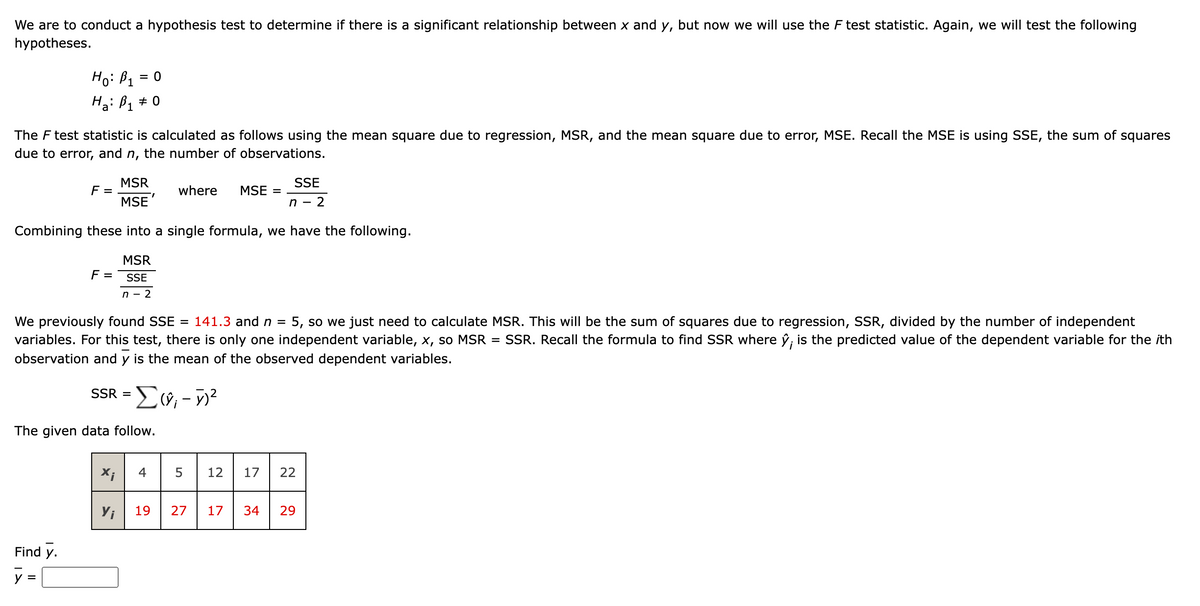We are to conduct a hypothesis test to determine if there is a significant relationship between x and y, but now we will use the F test statistic. Again, we will test the following hypotheses. Ho: P₁ = 0 Ha: B₁ * 0 The F test statistic is calculated as follows using the mean square due to regression, MSR, and the mean square due to error, MSE. Recall the MSE is using SSE, the sum of squares due to error, and n, the number of observations. F = MSR MSE where MSE = SSE n-2 Combining these into a single formula, we have the following. F = MSR SSE n-2 We previously found SSE = 141.3 and n = 5, so we just need to calculate MSR. This will be the sum of squares due to regression, SSR, divided by the number of independent variables. For this test, there is only one independent variable, x, so MSR = SSR. Recall the formula to find SSR where ŷ, is the predicted value of the dependent variable for the ith observation and y is the mean of the observed dependent variables. SSR = - Σ(9₁-7) ² The given data follow. X; 4 5 12 17 22 Y₁ 19 27 17 34 29 Find y. y =
We are to conduct a hypothesis test to determine if there is a significant relationship between x and y, but now we will use the F test statistic. Again, we will test the following hypotheses. Ho: P₁ = 0 Ha: B₁ * 0 The F test statistic is calculated as follows using the mean square due to regression, MSR, and the mean square due to error, MSE. Recall the MSE is using SSE, the sum of squares due to error, and n, the number of observations. F = MSR MSE where MSE = SSE n-2 Combining these into a single formula, we have the following. F = MSR SSE n-2 We previously found SSE = 141.3 and n = 5, so we just need to calculate MSR. This will be the sum of squares due to regression, SSR, divided by the number of independent variables. For this test, there is only one independent variable, x, so MSR = SSR. Recall the formula to find SSR where ŷ, is the predicted value of the dependent variable for the ith observation and y is the mean of the observed dependent variables. SSR = - Σ(9₁-7) ² The given data follow. X; 4 5 12 17 22 Y₁ 19 27 17 34 29 Find y. y =
Linear Algebra: A Modern Introduction
4th Edition
ISBN:9781285463247
Author:David Poole
Publisher:David Poole
Chapter7: Distance And Approximation
Section7.3: Least Squares Approximation
Problem 31EQ
Related questions
Question

Transcribed Image Text:We are to conduct a hypothesis test to determine if there is a significant relationship between x and y, but now we will use the F test statistic. Again, we will test the following
hypotheses.
=
Ho: P₁ 0
Ha: B₁ * 0
The F test statistic is calculated as follows using the mean square due to regression, MSR, and the mean square due to error, MSE. Recall the MSE is using SSE, the sum of squares
due to error, and n, the number of observations.
F =
MSR
MSE
where MSE =
SSE
n-2
Combining these into a single formula, we have the following.
F =
MSR
SSE
n - 2
We previously found SSE = 141.3 and n = 5, so we just need to calculate MSR. This will be the sum of squares due to regression, SSR, divided by the number of independent
variables. For this test, there is only one independent variable, x, so MSR = SSR. Recall the formula to find SSR where y; is the predicted value of the dependent variable for the ith
observation and is the mean of the observed dependent variables.
SSR = (y₁ - y)²
The given data follow.
X;
4
5 12 17 22
Yi
19 27 17 34 29
Find y.
y =
I
Expert Solution
This question has been solved!
Explore an expertly crafted, step-by-step solution for a thorough understanding of key concepts.
This is a popular solution!
Trending now
This is a popular solution!
Step by step
Solved in 2 steps with 1 images

Recommended textbooks for you

Linear Algebra: A Modern Introduction
Algebra
ISBN:
9781285463247
Author:
David Poole
Publisher:
Cengage Learning

Glencoe Algebra 1, Student Edition, 9780079039897…
Algebra
ISBN:
9780079039897
Author:
Carter
Publisher:
McGraw Hill

Linear Algebra: A Modern Introduction
Algebra
ISBN:
9781285463247
Author:
David Poole
Publisher:
Cengage Learning

Glencoe Algebra 1, Student Edition, 9780079039897…
Algebra
ISBN:
9780079039897
Author:
Carter
Publisher:
McGraw Hill